CARBON REMOVAL WEEKLY SUMMARY (12 AUGUST - 18 AUGUST 2024)-WEEK#33
Links to recent scientific papers, web posts, upcoming events, job opportunities, podcasts, and event recordings, etc. on Carbon Dioxide Removal Technology.
📝TABLE OF CONTENTS
1. Commercial News
2. Research Papers
3. Web Posts
4. Theses
5. Reports
6. Upcoming Events
7. Job Opportunities
8. Podcasts
9. YouTube Videos
10. Deadlines
Note: Click on the headings listed in the table of contents above to easily navigate to the sections you're interested in.
💸COMMERCIAL NEWS
Investors backed $225M World Bank Bond for Amazon Reforestation and carbon removal (Carbon Herald)
Canada Growth Fund invested up to $100 million in Svante, a leading global provider of carbon capture and removal solutions (Qunatum Commodity Intelligence)
Altman-Backed startup, Heimdal opened largest US facility to pull carbon from air. This facility has the potential to capture over 5,000 tons of CO2 annually (BNN Bloomberg)
Klimate announced a 1000 tonne purchase agreement with a new carbon removal supplier, Andes (LinkedIn)
CatonaClimate launched solution that embeds high-impact carbon removal into upstream AI infrastructure (PR Newswire)
Climeworks received first ever AAA rating from BeZero Carbon (Climeworks)
TerraFixing to package carbon removal, wind energy for cold climates. Iitial units can remove 1,000 tonnes of carbon dioxide from the atmosphere (Sustainable Biz)
Frontier shared their CDR offtake contract template to help CDR suppliers save more time to work on their solutions and advance market commitment (Frontiers)
BluSky, an innovative entry into the carbon removal clean technology sector announced its entry into a strategic marketing agreement with Euro Digital Media LTD (Street Insider)
InBC Invests in Arca Climate Technologies, Removing Carbon Dioxide from the Atmosphere (InBC)
8 Rivers and Siemens Energy Partner on Development Program of Carbon Capture Power Generation (8 Rivers)
📃RESEARCH PAPERS
Evaluating rainbowing for ocean alkalinity enhancement
Bianchi, R., Abbate, S., Lockley, A. J., Abbà, A., Campo, F., Varliero, S., ... & Caserini, S. (2024). Evaluating rainbowing for ocean alkalinity enhancement. Environmental Research Communications.
Synopsis: This study assesses Ocean Alkalinity Enhancement via rainbowing, where SL slurry is dispersed from ships. Simulations reveal that rainbowing requires high power to avoid environmental pH spikes, but even with significant dilution, it proves inefficient. Emissions nearly offset the carbon dioxide removal, achieving only 176 kg CO2 per ton of Ca(OH)2. Compared to ship-wake discharge, rainbowing is costlier and less effective, with costs at €388 per ton of CO2 removed versus €5.5.
Assessment of the Potential of Electrochemical Steps in Direct Air Capture through Techno-Economic Analysis
Rosen, N., Welter, A., Schwankl, M., Plumeré, N., Staudt, J., & Burger, J. (2024). Assessment of the Potential of Electrochemical Steps in Direct Air Capture through Techno-Economic Analysis. Energy & Fuels.
Synopsis: This study evaluates the long-term energy demand and levelized cost of capture (LCOC) for DAC technologies using liquid solvent absorption and solid adsorption. By comparing non-electrochemical and electrochemical DAC processes, it identifies the cell voltage needed for electrochemical steps to match or outperform non-electrochemical energy demands. Findings indicate that electrochemical processes could be competitive, but CapEx remains a significant factor, with uncertainties addressed through a range of initial data.
Seeing the forest for the trees: Implementing dynamic representation of forest management and forest carbon in a long-term global multisector model
Narayan, K. B., Patel, P. L., Wise, M., Snyder, A., Calvin, K. V., & Graham, N. T. (2024). Seeing the forest for the trees: Implementing dynamic representation of forest management and forest carbon in a long-term global multisector model. Environmental Research Letters.
Synopsis: This study implements a dynamic forest harvest model in GCAM, tracking forest age and adjusting rotation ages based on wood prices, age, and regional preferences. The model meets global wood demand with minimal old-growth loss, but economic pressures, especially in developing regions, drive deforestation more than wood harvesting. Carbon pricing leads to reduced rotation ages and a shift towards more carbon-efficient forest management, though forest cover may decrease due to competition with bio-energy crops.
When and why microbial-explicit soil organic carbon models can be unstable
Schwarz, E., Ghersheen, S., Belyazid, S., & Manzoni, S. (2024). When and why microbial-explicit soil organic carbon models can be unstable. Biogeosciences, 21(14), 3441-3461.
Synopsis: This study examines when and why unstable equilibrium points (EPs) occur in microbial-explicit soil organic carbon models, leading to unrealistic predictions. Instability arises when dissolved organic carbon (DOC) resupply depends on its abundance via a positive feedback loop. The study identifies a conservative condition in model parameters to ensure stability. It suggests three strategies to avoid instability: ignoring DOC dynamics, using biomass-independent uptake rates, or correlating parameter values to maintain stability, emphasizing the importance of ecological principles in model accuracy.
The London Convention and Protocol: Adapting to Address the Ocean-Climate Crisis
Vivian, C., & Del Savio, L. (2024). The London Convention and Protocol: Adapting to Address the Ocean-Climate Crisis. The International Journal of Marine and Coastal Law, 1(aop), 1-9.
Synopsis: This study addresses the need for clear regulations on ocean interventions like ocean fertilization and sub-sea carbon sequestration, which are gaining traction for mitigating climate change. These technologies, while aimed at accelerating CO2 uptake, may cause unintended environmental effects. The findings emphasize that international regulations must evolve with emerging technologies, grounded in scientific evidence, and aligned with public international law to protect the marine environment.
Adaptive stacked species distribution modelling: Novel approaches to large scale quantification of blue carbon to support marine management
Sheehy, J., Kerr, S., Bell, M., & Porter, J. (2024). Adaptive stacked species distribution modelling: Novel approaches to large scale quantification of blue carbon to support marine management. Science of The Total Environment, 174993.
Synopsis: This study introduces "Adaptively Stacked" Species Distribution Models (AS-SDMs) using Weighted Boosted Regression Trees (WBRTs) to predict blue carbon habitats in Orkney, including seagrass, maerl, and horse mussel abundance. The AS-SDMs integrate sediment thickness, carbon content, and sequestration potential, and a novel method characterizes substrates by mud, sand, and gravel inputs. Key findings estimate these habitats cover 657 km², store 16 Mt C, sequester 6000 t C annually, and have a potential value of £24.5 million, with six key project areas identified.
From carbon neutral to carbon negative: a theoretical bioenergy and CO2 removal retrofit at Ngāwhā geothermal power station
Titus, K., Dempsey, D., Peer, R., & Hanik, F. (2024). From carbon neutral to carbon negative: a theoretical bioenergy and CO2 removal retrofit at Ngāwhā geothermal power station. Journal of the Royal Society of New Zealand, 1-19.
Synopsis: In countries like New Zealand, where renewable electricity generation exceeds 80%, traditional decarbonization methods are limited. This study highlights how carbon dioxide removal technologies, leveraging geothermal and biomass resources, can drive sectors to net-zero emissions. A theoretical bioenergy retrofit at the Ngāwhā geothermal plant, using forestry residues, could remove 15.9 ktCO2/year with only 6% of available feedstock. Under the 2024 ETS, CDR revenue could surpass that of new electricity generation.
Evaluation and site selection for carbon storage via shallow CO2 injection into serpentinite in British Columbia, Canada
Steinthorsdottir, K., Rahimi, M., Dipple, G. M., & Snæbjörnsdóttir, S. Ó. (2024). Evaluation and site selection for carbon storage via shallow CO2 injection into serpentinite in British Columbia, Canada. International Journal of Greenhouse Gas Control, 137, 104222.
Synopsis: This study evaluates the potential for in-situ CO2 injection into serpentinite for carbon mineralization in British Columbia, Canada. Using multi-criteria index overlay analyses, 84 viable ultramafic formations were assessed for logistical feasibility, focusing on access to water, CO2 sources, and infrastructure. Three sites—Shulaps complex, Coquihalla serpentine belt, and Tulameen intrusion—were identified as prime candidates. Estimated CO2 storage capacities range from 141.2–18,682 MtCO2 at Shulaps to 2.8–373.6 MtCO2 at Tulameen. These sites will be further evaluated for pilot testing.
Geospatial assessment of the cost and energy demand of feedstock grinding for enhanced rock weathering in the coterminous United States
Li, Z., Planavsky, N. J., & Reinhard, C. (2024). Geospatial assessment of the cost and energy demand of feedstock grinding for enhanced rock weathering in the coterminous United States. Frontiers in Climate, 6, 1380651.
Synopsis: This study assesses the regional variability in carbon footprints, costs, and energy demands associated with feedstock grinding for ERW. Findings show that CO2 emissions from grinding are relatively low (5–35 kgCO2/ton) compared to ERW's CDR potential. Grinding costs vary regionally, averaging $0.95–5.81/ton with grid power and $1.35–8.26/ton with solar PV. Overall, energy demand for grinding is modest, accounting for less than 2% of annual U.S. electricity supply. Costs and energy requirements are projected to decrease over time, indicating that large-scale ERW deployment should have minor impacts on lifecycle emissions, cost-effectiveness, and energy efficiency.
Flexible strategies for carbon‐negative syngas and biochar poly‐generation via a novel chemical looping approach
Liu, G., Sun, Z., Wang, Z., Yu, B., Yang, X., Zhang, B., ... & Wu, Z. Flexible strategies for carbon‐negative syngas and biochar poly‐generation via a novel chemical looping approach. AIChE Journal, e18533.
Synopsis: The proposed pyrolysis chemical looping reforming-two stage regeneration (PCLR-TR) process addresses challenges in chemical looping gasification by separating pyrolysis and reforming, allowing flexible H2/CO ratio adjustments. The two-stage regeneration enhances reaction synchronization and reduces the exothermic intensity of the second stage by 58% with CO2 feed. Optimization shows the syngas can achieve a maximum CO2 negative emission of 1.85 kg/kg, making the PCLR-TR system a versatile and eco-friendly solution for energy and chemical industries.
Enhanced woody biomass production in a mature temperate forest under elevated CO2
Norby, R. J., Loader, N. J., Mayoral, C., Ullah, S., Curioni, G., Smith, A. R., ... & MacKenzie, A. R. (2024). Enhanced woody biomass production in a mature temperate forest under elevated CO2. Nature Climate Change, 1-6.
Synopsis: This study investigates the impact of elevated CO2 on mature forests, focusing on a 180-year-old Quercus robur woodland in England. Using tree-ring analysis and canopy laser scanning, we found that the woodland increased woody biomass production and carbon exudation into the soil under free-air CO2 enrichment (FACE) over 7 years. These findings suggest that mature temperate forests can significantly contribute to climate change mitigation by enhancing carbon sequestration and influencing nutrient cycles.
Policy support for BECCS and DACCS in Europe: the view of market participants
Yang, P., Fankhauser, S., Smith, S. M., Sundvor, I., Hirmer, S., Johnstone, I., & Stemmler, J. (2024). Policy support for BECCS and DACCS in Europe: the view of market participants. Environmental Research Letters, 19(9), 094022.
Synopsis: This paper explores the role of government intervention in fostering a Carbon Dioxide Removal industry, focusing on BECCS and DACCS. Surveys and interviews with 47 project developers and financiers in Europe reveal a preference for compliance markets linked to emissions trading systems to drive demand. Participants also emphasize the need for government support to mitigate early market risks, rigorous monitoring, and regulation to maintain environmental integrity. Policymakers face challenges in scaling CDR, balancing with emissions cuts, ensuring fairness, and speeding up deployment.
Continuous straw returning enhances the carbon sequestration potential of soil aggregates by altering the quality and stability of organic carbon
Zhang, J., Zhang, F., & Yang, L. (2024). Continuous straw returning enhances the carbon sequestration potential of soil aggregates by altering the quality and stability of organic carbon. Journal of Environmental Management, 358, 120903.
Synopsis: This study examines how long-term straw return affects soil organic carbon sequestration and soil structure in oasis farmland in arid northwest China. Results show straw return increases SOC, particulate OC, and mineral-associated OC by up to 63.51%, 31.00%, and 226.00%, respectively. Over time, microaggregates convert to macroaggregates, with the highest soil stability observed after 10 years. Solid-state 13C NMR reveals O-alkyl C as the dominant component, with increases in aromatic C and hydrophobicity peaking at 10 years. The study confirms that long-term straw return enhances soil structure and stabilizes OC, improving carbon sequestration.
Eddy Covariance Evaluation of Ecosystem Fluxes at a Temperate Saltmarsh in Victoria, Australia Shows Large CO2 Uptake
Reef, R., Daly, E., Anandappa, T., Vienna-Hallam, E. J., Robertson, H., Peck, M., & Guyot, A. (2024). Eddy Covariance Evaluation of Ecosystem Fluxes at a Temperate Saltmarsh in Victoria, Australia Shows Large CO 2 Uptake. EGUsphere, 2024, 1-27.
Synopsis: Using eddy covariance at a temperate saltmarsh on French Island, Victoria, this study measured CO2 fluxes, gas gradients, and environmental factors. The marsh, dominated by Sarcocornia quinqueflora, showed seasonal flux variations, with net ecosystem productivity (NEP) averaging 10.54 g CO2 m-2 day-1 in the growing season and 1.64 g CO2 m-2/day in winter. Despite lower respiration rates in winter, the marsh remained a CO2 sink due to some evergreen species. Annual NEP was estimated at 753 (±112.7) g C m-2/yr, aligning with temperate saltmarshes in Europe and higher than the global saltmarsh average of 382 g C m-2/yr, but half of global mangroves.
Acid–base concentration swing for direct air capture of carbon dioxide
Rinberg, A., & Aziz, M. J. (2024). Acid–base concentration swing for direct air capture of carbon dioxide. Energy Advances.
Synopsis: This study presents the first experimental evidence of the acid–base concentration swing (ABCS) method for direct air capture of CO2. The ABCS process utilizes Le Chatelier's principle, where concentrating acid–base reactants acidifies the solution, causing CO2 to outgas. Re-dilution reverses this, allowing CO2 absorption. The system tested includes sodium cations, boric acid, and a polyol complex, though it faces rate and capacity limitations. Theoretical models show higher reaction orders (up to fourth-order) improve cycle capacity and reduce thermodynamic work to around 150 kJ per mole of CO2. The ABCS method benefits from compatibility with existing desalination technologies, offering potential for energy recovery and direct CO2 extraction.
Interannual variations in Siberian carbon uptake and carbon release period
Tran, D. A., Gerbig, C., Rödenbeck, C., & Zaehle, S. (2024). Interannual variations in Siberian carbon uptake and carbon release period. Atmospheric Chemistry and Physics, 24(14), 8413-8440.
Synopsis: This study examines how warmer winters affect CO2 release and the annual terrestrial carbon sink using data from the Zotino Tall Tower Observatory (ZOTTO) in Siberia (2010–2021). Analysis of atmospheric CO2 records reveals increased carbon release during cold months and a rise in the length and intensity of carbon release periods (CRP), while carbon uptake periods also increased but less markedly. These trends indicate that despite greater growing-season CO2 uptake, higher winter respiration negates net annual CO2 absorption due to warming. Extreme events like the 2012 wildfire and 2020 heat wave influenced the data, but inversion-derived net ecosystem exchange fluxes did not show these trends, highlighting limitations in attributing regional ecosystem contributions to observed CO2 flux changes.
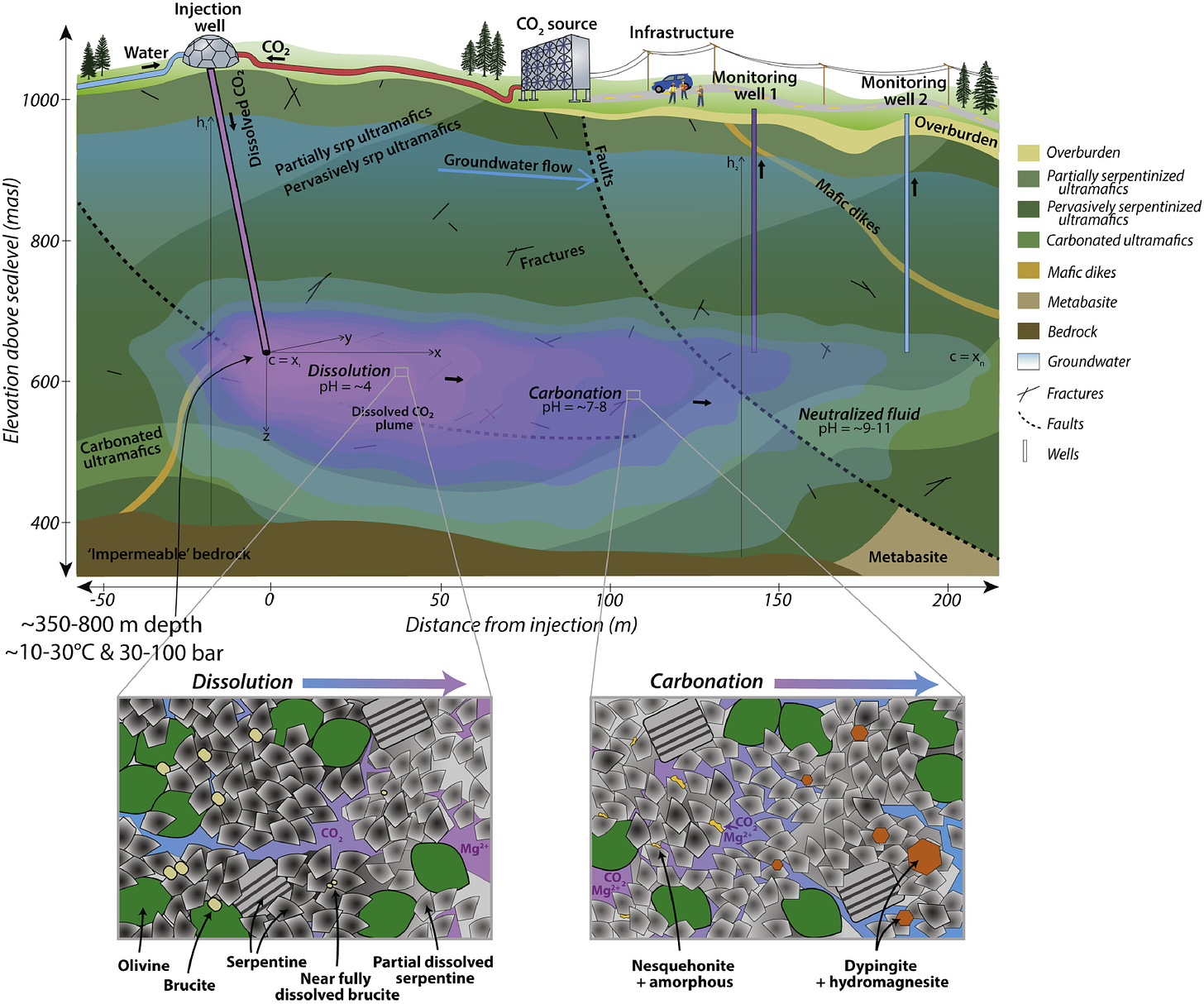
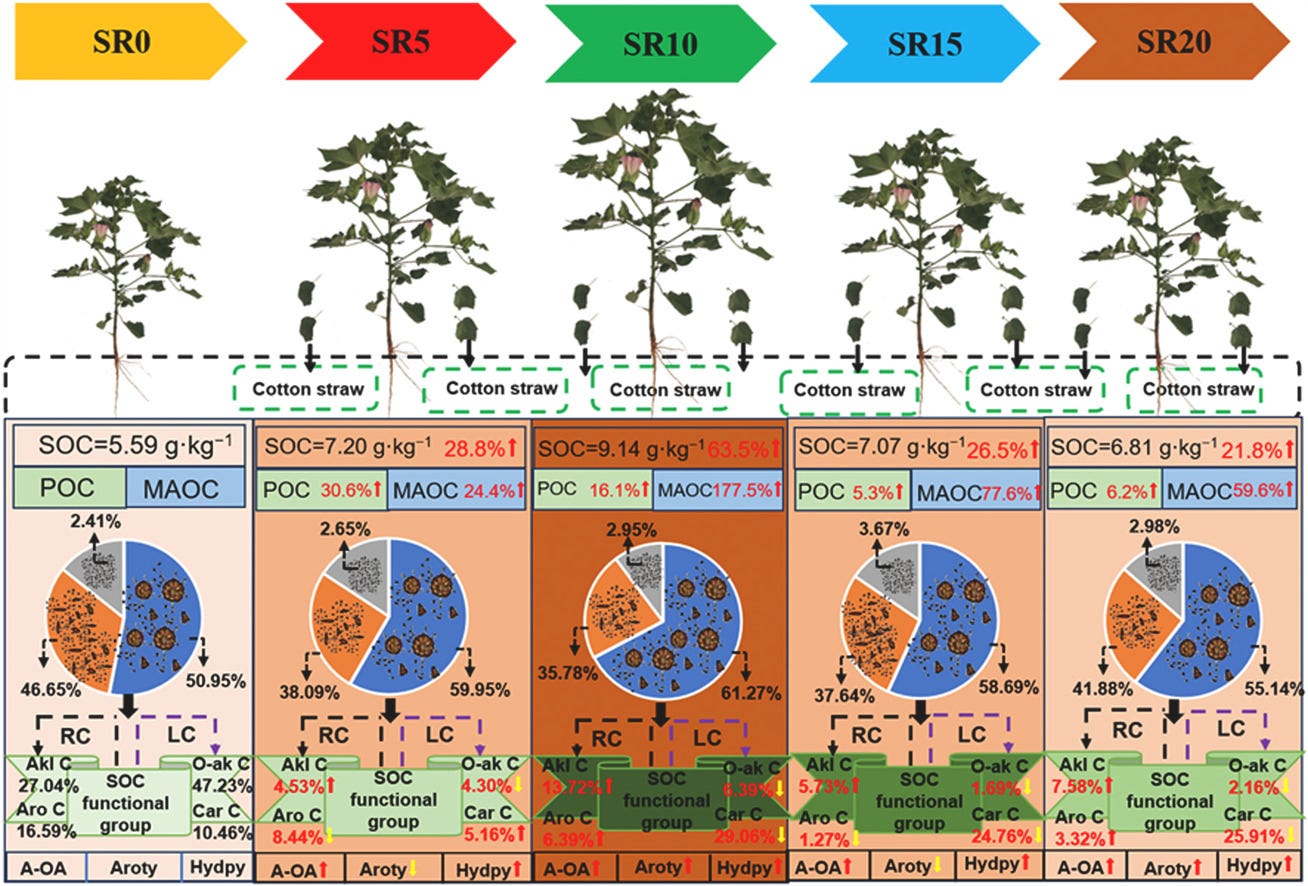
📰WEB POSTS
Net Zero’s Carbon Removal Conundrum (Bloomberg)
Q&A: A climate scientist’s evolution on carbon removal (E&E News)
The Game-Changer in Carbon Removal: What You Need to Know About SB308 (Carbon Capture)
The birth of the carbon removal market (yahoo!finance)
We’re still in the 1970s with cement’: Norway plant to blaze carbon-free concrete trail (The Guardian)
Mature trees offer hope in world of rising emissions (BBC News)
Amount of planet-warming carbon dioxide that Oregon farmland absorbs overinflated, study finds (Oregon Capital Chronicle)
The Path to Responsible Mining (Climate Grift)
ERW developer sales fall amid weak fertiliser demand in Brazil (Quantum Commodity Intelligence)
We pumped extra CO₂ into an oak forest and discovered trees will be ‘woodier’ in future (The Conversation)
Will regulators OK controversial effort to supercharge ocean’s ability to absorb carbon? (Science)
Woods Hole Oceanographic Institution announced shift of Ocean Alkalinity Enhancement field trials to summer 2025 (WHOI)
Isometric released 2 modules new modules for carbon storage via mineralization (Isometric)
How biochar can help China reach carbon neutrality (Dialogue Earth)
Calculating Eion’s Carbon Impact (Our Life Cycle Assessment) (Eion)
Carbon-Removal Firms Have One Very Big Backer. That’s a Problem (WSJ)
How Biochar Can Accelerate Your Net Zero Journey (Medium)
Relentless Pursuit of System Optimization and Engineering Excellence does not apply to Carbon Capture (XCaptureCO2)
📖THESES
Aqueous Batteries for Large-Scale Energy Storage and Carbon Removal Applications
The ethics of carbon dioxide removal: Differentiating agents and responsibilities to remove carbon dioxide
📋REPORTS
Report on regional and global governance challenges and opportunities for emerging ocean-based NETs (GEOMAR)
Report on the Future Contribution of Ocean NETs in Different Climate Policies (GEOMAR)
Good governance of marine carbon dioxide removal, Policy Brief (GEOMAR)
Enhanced rock weathering: Potential UK greenhouse gas removal (Postnote)
The Big Opportunities in Biogenic Emissions (BCG)
Innovations & Cost Reductions in Direct Ocean Capture (Caprura)
MAAP #215: Unprecedented Look at Carbon across the Amazon (part 1) (Amazon Conservation)
Taking stock of carbon dioxide removal
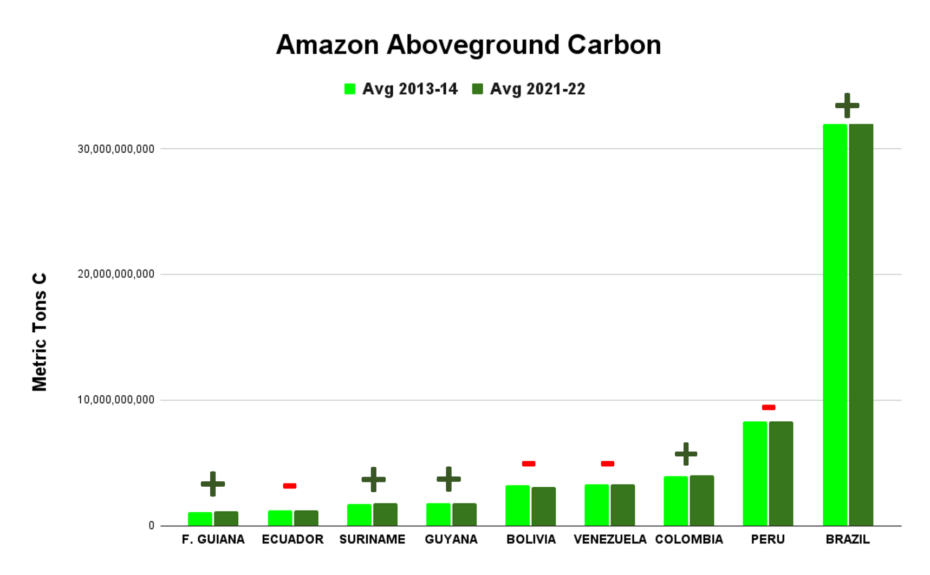
🗓️UPCOMING EVENTS
This Is CDR: The Carbon Removal Standards Initiative with Anu Khan by The OpenAir Collective | 20 August 2024 | Online
(NEW) Current Realities in Carbon Removal: Nature-Based and other Affordable Solutions by Ccarbon | 20 August 2024 | Online
Collaborating with Smallholder Farmers to Remove Carbon by Carbon Standards International | 22 August 2024 | United Kingdom
Exploring the Ethics and Societal Interactions of Climate Intervention by the U.S. National Science Foundation | Register before 23 August 2024
Discovery workshop focussing on terrestrial science (CDR) | 22 October 2024 | Online
Discovery workshop focussing on ocean science (CDR) | 25 October 2024 | Online
Integrative synthesis workshop focusing on identifying gaps in current governance & ethics | 18 November 2024 | Online
CO2 Removal Spring School 2024 by University of Tasmania | 2-6 September 2024 | UTAS Hedberg facility, University of Tasmania, Hobart
Digging into the Terrestrial Pathway with Carbon Lockdown by Climate Vault | 04 September 2024 | Online
Panel Discussion: ‘Climate overshoot: devastating risks and possible responses’ by University of Oxford | 10 September 2024 | Oxford, London
Unlocking Technological Innovation with Octavia Carbon by Climate Vault | 11 September 2024 | Online
2024 Carbon Removal Capital Summit by XPRIZE & Santander CIB | 10-12 September 2024 | San Francisco
Carbon Unbound Europe | 11-12 September 2024
Responsible Carbon Removal Workshop: Centering Indigenous Leadership by Carbon Removal Canada | 12 September 2024 | British Columbia
Carbfix Mineralization Summit 2024 | 12-13 September 2024
Grounding Carbon Farming at Wageningen University & Research by WIMEK in collaboration with SBL, ENP, NGO myclimate, and the farm "La ferme de Hyaumet" | 14-20 September 2024 | France
(NEW) Community-Centered CDR: Opportunities and Challenges by Institute for Responsible Carbon Removal | 17 September 2024 | Online
(NEW) Understanding the Role of Carbon Dioxide Removal in Long-term Climate Planning by World Resources Institute | 17 September 2024 | Online
Advancing a Transparent and Responsible mCDR Industry by Ocean Visions and Hourglass Climate | 17 September 2024 | Online
(NEW) Financing resilience through carbon removal by Klimate.co | 18 September 2024 | Online
Carbon Clean-up Camp | 19-22 September 2024 | UK
(NEW) EU Carbon Removal Certification Framework: Rules on Verification and Registries - Stakeholder Workshop by EU Commission | 23 September 2024 | Online & In Person (Brussels)
CDR Community Happy Hour: Climate Week NYC Edition! by Carbon Business Council & 3 others | 23 September 2024 | New York
(NEW) Accelerating Research, Development, and Demonstration for Responsible Marine Carbon Dioxide Removal – Where Are We on the Road to 2030? by Ocean Visions | 23 September 2024 | New York
(NEW) Puro.earth NY Climate Week CDR Summit by Puro.earth Americas | 24 September 2024 | New York
CRCF Online Workshop: Carbon Storage Certification of Buildings by EU | 24 September 2024 | Online
Great Plains Biochar Conference by The University of Nebraska–Lincoln Department of Agronomy and Horticulture, the Nebraska Forest Service and the Nebraska Biochar Initiative | 24-26 September 2024 | Nebraska
(NEW) Hope for the Cryosphere? An Introduction to Ocean Visions’ Road Map of Potential Approaches to Slow the Loss of Arctic Sea Ice by Ocean Visions | 25 September 2024 | New York
The Biochar Carbon Revolution by Grain Ecosystem | 25 September 2024 | Manhattan, New York
CO2NNECT 2024 by the Great Plains Institute's Carbon Action Alliance | 29 September - 01 October 2024 | Colorado
Bellona Climate Action Conference | 01 October 2024 | Brussels (Belgium)
EO for Monitoring, Reporting, and Verification of Carbon Removals by European Environment Agency | 8-11 October 2024 | Copenhagen | Register before 10 September 2024
Carbon Removal Canada's Policy Report Launch: Procuring with Purpose by Carbon Removal Canada | 09 October 2024 | Ottawa, Canada
Volcanoes and past climate: adventures with deep carbon | 12 October 2024 | Online & ExCeL London
IBI Biochar Study Tour: Italy by the Italian Biochar Association and the International Biochar Initiative | 16-18 October 2024 | Florence, Italy
5th EU Carbon Removals Expert Group meeting | 21-23 October 2024 | Online
Carbon Unbound West Coast | 25-26 October | San Francisco, USA
The State of Durable Carbon Removal by Verge | 29 October 2024 | California, US
Carbon Removal Pathways We Don't Talk About Enough by Verge | 30 October 2024 | California, US
From Wetlands to the Deep Ocean: Dive Into Marine-Based Carbon Removal by Verge | 30 October 2024 | California, US
Getting to Gigatonne: Barriers (and Pathways) to Scaling Carbon Removal In The Next 25 Years by Verge | 30 October 2024 | California, US
How to apply biochar in sustainability management and accounting | German Biochar Forum | 18 November 2024
Industrial Energy Green Transition 2024 | 3-5 December 2024 | Tokyo
Scoping Workshop: Leaky deltas: sources or sinks in the global carbon cycle? by OCB | 17-20 March 2025 | Baton Rouge, LA
Bio-Char IV Conference | May 18-23, 2025 | Santa Marta, Colombia
We have curated a “Carbon Removal Events Calendar.” Explore and stay informed about upcoming events, conferences, and webinars on Carbon Dioxide Removal technology. Sync specific events / all events to your default calendar to ensure you never miss out on important CDR updates.
GUIDELINES:
Sync selected events to your default calendar in these simple steps:
1) Click on the event you want to sync.
2) Tap the menu icon (three vertical lines) at the top left.
3) Choose 'Share.'
4) Pick your default calendar.
5) Save the event.
Sync the entire Teamup Calendar to your default calendar with these simple steps:
1) Tap the menu icon (three vertical lines) at the top right.
2) Choose 'Preferences.'
3) Click 'iCalendar Feeds.'
4) Copy the URL shown for 'CDR Events / CDR General Guidelines / CDR Job Deadlines.'’
5) Paste the URL into your default calendar settings.
6) Click 'Subscribe' or 'Add Calendar.'
For more detailed instructions, visit: https://calendar.teamup.com/kb/subscribe-to-teamup-icalendar-feeds/
You can directly sync all Carbon Removal events to your default calendars by pressing the link below:
💼JOB OPPORTUNITIES
Research Assistant or Associate in Carbon Dioxide Removal at Imperial | London | Deadline to apply: 01 September 2024
"The project aims to investigate the value of different biomass-based pathways for CO2 removal from the atmosphere. The CO2 removal technologies that will be investigated include biochar, bioenergy with carbon capture and storage (BECCS) pathways, e.g., to produce electricity, heat, hydrogen and other fuels, as well as biomass carbon removal and storage (i.e., no energy product). The study will evaluate the process-level performance and the impact at a systems-level in the context of net zero transitions."
Director of Information Technology at Graphyte | Remote
"Combining photosynthesis with practical engineering, Graphyte’s Carbon Casting technology provides an immediate pathway for billions of tons of low-cost, durable carbon removal."
Freelance PT Research Associate at Circular Carbon
"The Circular Carbon Network is an initiative of the Carbon XPRIZE that is focused on catalyzing more investment and commercial activity in the emerging Circular Carbon Economy to help accelerate its growth and realize its full economic and climate potential."
Community Engagement Coordinator at Lithos Carbon | Bellevue, Washington, United States
"Lithos Carbon remove atmospheric carbon for a fraction of the cost while increasing crop yields. Their process is highly efficient, increases soil health, and repurposes post-industrial waste. Then we sell the carbon credits to companies and split revenue with our regenerative growers."
Senior People Operations Manager at Charm Industrial | Fort Lupton, Colorado, United States
"Charm Industrial is working to return the atmosphere to 280 ppm CO₂. We design, build and operate a fleet of mobile fast pyrolyzers that convert ag and forest biomass residues into bio-oil for use in carbon removal and direct-reduced-iron steelmaking."
Carbon Removal Scientist - Terrestrial Biomass-Based Carbon Storage at Isometric | New York City, London
"Isometric is a carbon removal registry. We issue the world’s most scientifically rigorous carbon credits to help Fortune 100 companies tackle climate change and prevent greenwashing."
Director, Carbon Markets at CarbonCure | Remote
"CarbonCure Technologies is on a mission to make concrete a climate solution, reducing embodied carbon emissions in the built environment and transforming concrete plants into a worldwide network of carbon removal factories."
CDR Advisor at Bellona Europa | Brussels, Belgium | Deadline to apply: 01 September 2024
"Bellona Europa is an international, independent, and non-profit organisation that meets environmental and climate challenges head on. We are solutions-oriented and have a comprehensive and cross-sectoral approach to assess the economics, climate impacts and technical feasibility of necessary climate actions. To do this, we work with civil society, academia, governments, institutions, and industries. We are based in Brussels."
Junior Subsurface Engineer at Vaulted Deep | Houston TX
"Vaulted is an emerging leader in permanent carbon removal. As a Biomass Carbon Removal and Storage (BiCRS) solution, Vaulted delivers permanent, high quality carbon removal at scale through the geologic sequestration of carbon-filled organic waste."
Controller at Paebble | Rotterdam, the Netherlands
"Paebbl is a founder-led start up in the emerging field of climate technology and the new “carbon economy”. Our mission is to permanently sequester CO2 and repurpose it into products that the world needs. Inspired by natural CO2 mineralization, our technology accelerates this process by a factor of a million and is now ready for scale-up. We are privately financed by supportive, long-term oriented institutional and private investors, and our diverse team includes experts from technology, industrial engineering, digital innovation, waste management, finance, and academia."
Research Assistant/Associate in Arctic climate dynamics at University of Cambridge | Deadline to apply: 28 August 2024
"Research Project: The Arctic region has warmed at least twice as rapidly as the global warming trend. Arctic sea-ice has declined dramatically over the past few decades and an ostensibly ice-free summer Arctic in the near future seems like a real possibility. This would have significant global and regional implications and could trigger undesirable feedbacks (e.g. albedo feedback, ocean circulation disruptions). The goal of this project is to explore possible interventions that can hinder the decline trend or help regenerate sea-ice more effectively. The postdoctoral work will focus on high-resolution realistic modelling of the Arctic region, with a focus on ice-ocean interactions. The project will focus on I) enhancing scientific understandings of the physics of sea-ice and its interaction with the density stratified ocean beneath, II) use such knowledge to inform their representation in state-of-art models, and III) use the models to inform possible intervention design and quantify their potentials and hazards."
Science Director at Homeworld Collective | Boston
"Homeworld Collective is a non-profit dedicated to fostering the growth of climate biotech and strengthening its interconnections with other climate tech fields. Our ethos is action-oriented optimism about climate change: we believe that if we take action, we will get better outcomes. Our work centers on synthesizing actionable knowledge through community engagement, communicating that knowledge to lift all boats, and empowering practitioners to pursue solutions toward the collective goal of a thriving biosphere."
CDR Scientist, Rating at BeZero Carbon | London or Remote
"BeZero Carbon is a global ratings agency for the Voluntary Carbon Market. We distribute our ratings via our SaaS Product, BeZero Carbon Markets, informing all market participants on how to price and manage risk. Our ratings and research tools support buyers, intermediaries, investors and carbon project developers."
Head of Carbon Credits at SCW Systems
"At SCW Systems, we believe in the power of innovation to combat climate change. Our Direct Air Capture technology, combined with groundbreaking energy efficiency, enables us to capture CO₂ directly from the air and store it permanently. This offers national and international companies a unique opportunity to offset their CO₂ emissions and achieve their sustainability goals."
MRV-Researcher at Aeroc | Köln, North Rhine-Westphalia, Germany
"Aeroc is a German start-up specializing in the development and scaling of Enhanced Rock Weathering (ERW) for permanent CO2 sequestration. Our goal is to develop innovative climate protection solutions that are both ecologically and economically sustainable. In collaboration with renowned partners, we are working to establish ERW technology in agriculture and thus make a significant contribution to reducing greenhouse gases."
Analyst, Carbon Origination at Catona Climate | United States
"Catona Climate is a climate finance company that delivers high-quality carbon solutions to businesses everywhere, helping transform climate pledges into measurable action through rigorously vetted high-impact nature-based carbon projects around the world."
🎙️PODCASTS
Shiladitya Ghosh (Mission Zero Technologies) | Climate Pioneers
"For the first episode of series 6, I spoke with Shiladitya Ghosh, co-founder and COO at Mission Zero Technologies (DAC), who are working to scale affordable direct air capture, and have gone from lab to commercial plant in under three years!
Across this series we will be discussing the challenges around scaling deep tech solutions within climate. I’ll be speaking to Investors, Founders, Venture Builders and other key ecosystem players all focused on scaling and commercialising groundbreaking, deep tech innovations.
We will explore how to prepare for the challenges that deep tech companies often face around fundraising, scaling, team building and commercialisation; and we’ll hear from stories of those who have successfully scaled to Series A and beyond."
Big Tech Betting on Nature-Based Carbon Removals | MCJ Podcast
"Julia Strong is the Executive Director of Symbiosis Coalition. Announced in early 2024, Symbiosis Coalition is an advanced market commitment from Google, Meta, Microsoft, and Salesforce to purchase up to 20 million tons of nature-based carbon removals.
The forestry credit space has faced challenges over the last couple of years, prompting interest in how Julia and these large tech companies collaborated to stimulate activity in the sector. Conversations about forestry should be relatively straightforward, considering forests, along with oceans and soil, are natural carbon sinks. Preserving and restoring forests is crucial, yet the complexity surrounding forestry credits always brings new insights. We’re grateful to Julia for sharing more about the formation of Symbiosis Coalition, criteria for high-quality credits, barriers to bankability, and more."
Ben Rubin | The CDR Procurement Guide
"Some of the highlights from this episode:
-Buyer resources through Carbon Business Council and The Carbon Herald partnership
-Importance of science-based communication: 3 ‘R’s of climate: remove, reduce, resilience
-The need for better education of critical stakeholders on risks and benefits of CDR
-Unique buyer journeys and resources (CBC/BMWF paper on buyer experience)
-Concept Of ‘Twin Targets’ For Net Zero Pledge: reduction and removal (joint letter and OpEd)
-Critical Need For Demand-Side Support: public-led procurement (CDC paper this autumn)
-Scaling to gigaton levels: increasing demand and supply
-Communities for learning about CDR"
Benjamin Schulz | The CDR Procurement Guide
"Some of the highlights from this episode:
-The importance of developing specific communication and education strategies for different audiences using simple, easily to understand concepts - thinking about carbon removal as necessary waste management, where you have to remove what you emit.
-The necessity for novice buyers to be able to learn from pioneer buyers - industry and market peers need to help each other.
-The importance of establishing a price for carbon to drive the right organisation behaviours and fund transition activity and compensation of residual/historic emissions.
-Funding the first feature length CDR documentary through the Legion44 initiative to bring CDR to the wider public - launching at Venice Film Festival.
-The importance of public long term multi-year CDR procurement commitments for both sides of the market.
-The policy environment that is emerging is creating greater certainty for organisations with net zero claims about the action they will need to take.
-Call To Action: Lobby for a price to be put on carbon by society and within organisations to fund carbon waste management."
🎥YOUTUBE VIDEOS
CDR: A required Piece in a Net Zero Strategy - Dominic Lüdin (Chief Growth Officer, Carbonfuture) | Carbon Exposure Project
"This new CXP episode is featured by Dominic Lüdin, Chief Growth Officer at Carbonfuture. Carbonfuture aims to accelerate climate action with the Trust Infrastructure for durable carbon removal. Rene and Dominic discuss the development and growth of CDR, how CDR should be combined with carbon reduction strategies and the durability of CDR projects."
Episode 3 - Rahul Shendure, Chief Executive Officer, CarbonBuilt | Decarbonization Disruptors Podcast
"I had the privilege to interview Rahul Shendure, Chief Executive Officer of CarbonBuilt. CarbonBuilt's technology enables the production of ultra low-carbon concrete products, driving gigatonne-scale greenhouse gas reductions through the cost-effective mineralization of carbon dioxide
Rahul shared his career journey starting in the Chemical & Plastics manufacturing industry with the mission to focus on solutions for environmental pollution. Rahul talked about his introduction to early stage investing in cleantech and healthcare startups and how he evaluates companies for investment both by their solution and more importantly their people.
We discussed in detail Rahul's role at CarbonBuilt and how they are tackling the massive problem of carbon reduction in the manufacturing of concreate. It was enlightening to hear how CarbonBuilt is revolutionizing the way concreate is produced, a process that that largely been unchanged in over 100 years.
There is not silver bullet in decarbonization, but CarbonBuilt is a great example of advanced technology to reduce global carbon emissions implemented in a practical and cost effective way."
Biochar Expert Panel Healthy Planet Action Coalition Dec. 1, 2022 | Healthy Planet Action Coalition
"Conversation with Bichar Expert Panel led by Brian von Herzen and including Albert Bates, Paul Anderson, Hugh McLaughlin and others."
How carbon removal can address the climate crisis | Carbon Removal Canada
"In this video, our co-founder and executive director, Na'im Merchant, explains the importance of carbon removal and its role in addressing the climate crisis.
Carbon Removal Canada is a nonpartisan think tank focused on scaling carbon removal solutions responsibly to help Canada meet its climate goals by 2050. Discover how we are helping Canada take action and remove carbon dioxide from the atmosphere (in addition to cutting emissions)."
Epiphyte Weekly Stream! Open Source DAC | OpenAir
Turning the world’s largest waste stream into a CO2 sink | Anna Haas | TEDx Talks
"To reach net zero by 2050, we need to drastically reduce our emissions as well as remove the residual, hard-to-abate emissions from the atmosphere via carbon removal. One method with widespread potential: capturing CO2 from the atmosphere and storing it in the world’s largest waste stream, demolition concrete, via a mineralization process. Anna Haas holds an M.Sc. in mineral resources engineering from RWTH Aachen University. She brings cross-industry experience from startups to corporates, having lived in 5 countries and now calling Switzerland home. Anna has worked in the Swiss machine building industry and a German VC-backed ConTech startup. Currently, she is a Sales Manager at Neustark, an ETH Zürich spin-off enabling carbon storage in mineral waste streams. Passionate about innovations for a better world, she’ll share insights on her work with carbon."
Thoughts on Epiphyte Tube Design - parts, heating, vacuum | OpenAir
"Some early thoughts on how we might shift to the PFTE tube design, and incorporate heating and vacuum."
SB 308 Appropriations Hearing Livestream | OpenAir
"OpenAir is livestreaming to Streamyard, Youtube and LinkedIn the Assembly Appropriations hearing, during which SB 308 (Becker) will be voted on. This is a critically important moment for the bill, as Appropriations is the final committee before the bill would be voted on in the Assembly, likely next week. If it makes it out of the Assembly, it's on to the Governor's desk."
Weekly Carbon Removal Updates from 12 August - 18 August 2024 | Carbon Removal Updates Bulletin
🚨DEADLINES
Event Registration Required: Exploring the Ethics and Societal Interactions of Climate Intervention by the U.S. National Science Foundation | Register before 23 August 2024
The India Accelerator Program by Remove | Deadline to apply: 25 August 2024
Call for tenders for a study on "Carbon Sequestration Capacity of Seabeds" by European Climate, Infrastructure and Environment Executive Agency | Deadline: 29 August 2024
Student Monitoring and Reporting Technology for Carbon Dioxide Removal Competition by Mission Innovation | Proposals are due by 09 September 2024
The Europe Accelerator Program by Remove | 09 September 2024
Funding opportunity: An invitation to artists and creatives by The CO2RE Artists, Arts and Humanities Greenhouse Gas Removal (GGR) Initiative | 09 September 2024
The European Commission has announced a $30 million (€28.5 million) call for proposals to provide funding for carbon dioxide removal projects in the EU | Deadline: 17 September 2024
(NEW) Call for Papers: EJRR Special Issue on Climate Interventions Governance (Carbon Dioxide Removal, Solar Radiation Modification, Regional Intervention)
Abstract Submission Deadline: 01 October 2024
Full Manuscript Submission Deadline: 31 December 2024




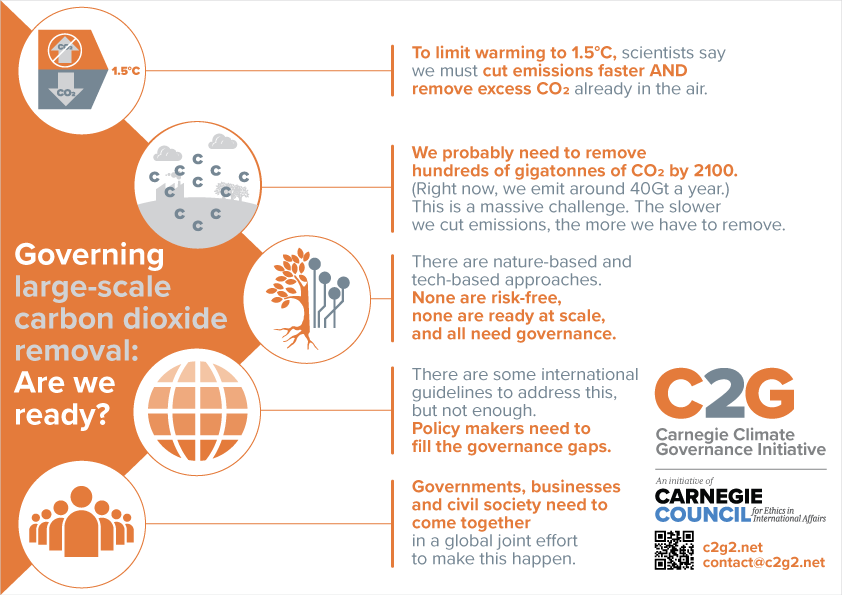


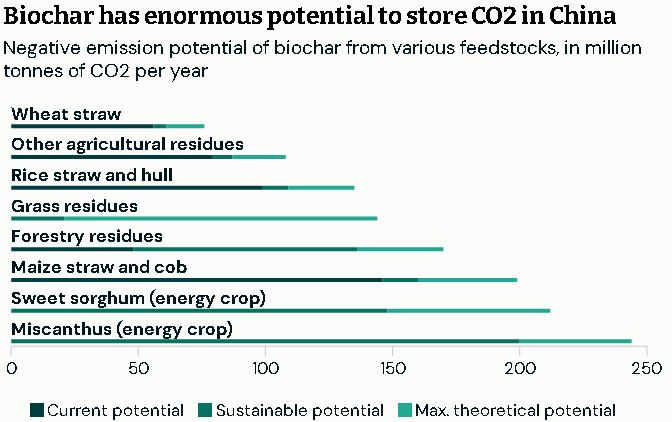
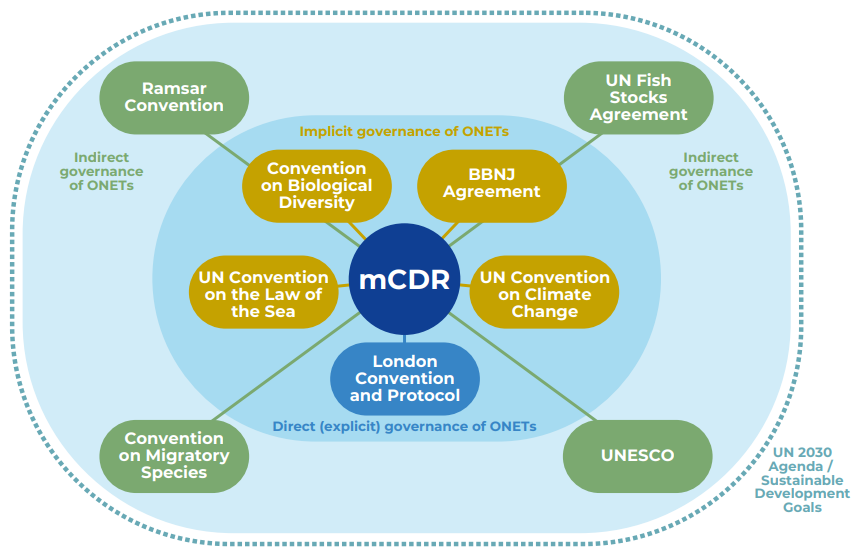
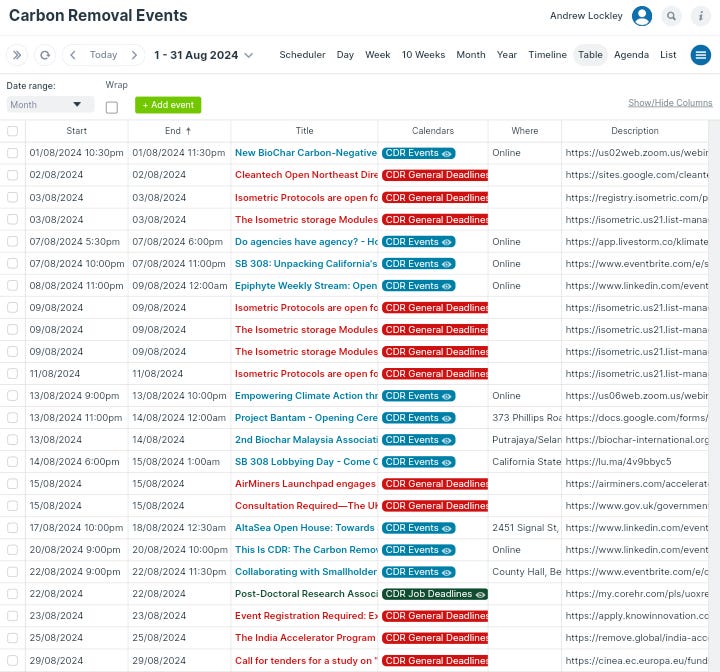
This is an amazingly valuable resource for anyone in the emerging Climate Restoration market and movement!